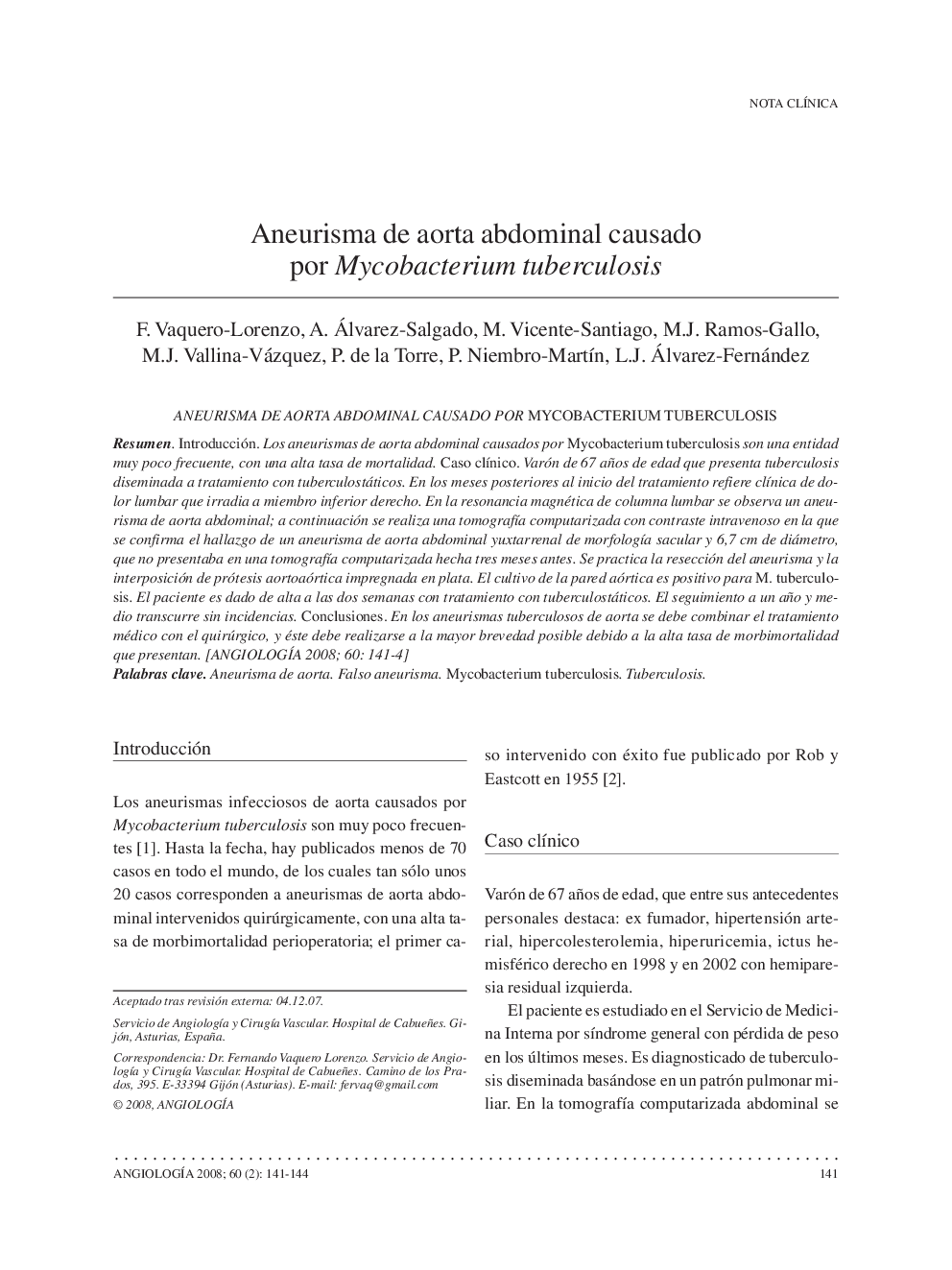| Article ID | Journal | Published Year | Pages | File Type |
|---|---|---|---|---|
| 2867942 | Angiología | 2008 | 4 Pages |
ANEURISMA DE AORTA ABDOMINAL CAUSADO POR MYCOBACTERIUM TUBERCULOSISResumen.Introducción. Los aneurismas de aorta abdominal causados por Mycobacterium tuberculosis son una entidad muy poco frecuente, con una alta tasa de mortalidad. Caso clínico. Varón de 67 años de edad que presenta tuberculosis diseminada a tratamiento con tuberculostáticos. En los meses posteriores al inicio del tratamiento refiere clínica de dolor lumbar que irradia a miembro inferior derecho. En la resonancia magnética de columna lumbar se observa un aneurisma de aorta abdominal; a continuación se realiza una tomografía computarizada con contraste intravenoso en la que se confirma el hallazgo de un aneurisma de aorta abdominal yuxtarrenal de morfología sacular y 6,7 cm de diámetro, que no presentaba en una tomografía computarizada hecha tres meses antes. Se practica la resección del aneurisma y la interposición de prótesis aortoaórtica impregnada en plata. El cultivo de la pared aórtica es positivo para M. tuberculosis. El paciente es dado de alta a las dos semanas con tratamiento con tuberculostáticos. El seguimiento a un año y medio transcurre sin incidencias. Conclusiones. En los aneurismas tuberculosos de aorta se debe combinar el tratamiento médico con el quirúrgico, y éste debe realizarse a la mayor brevedad posible debido a la alta tasa de morbimortalidad que presentan. [ANGIOLOGÍA 2008; 60:141-4]
ABDOMINAL AORTIC ANEURYSM CAUSED BY MYCOBACTERIUM TUBERCULOSISSummary.Introduction. Abdominal aortic aneurysms caused by Mycobacterium tuberculosis are a very rare entity, with a high mortality rate. Case report. We report the case of a 67-year-old male who presented disseminated tuberculosis that was being treated with tuberculostatic compounds. During the months following the start of treatment, the patient reported symptoms of lower back pain that irradiated to the right lower limb. Magnetic resonance imaging of the lumbar spine showed an abdominal aortic aneurysm; computerised tomography with intravenous contrast was then performed and this confirmed the finding of a juxtarenal abdominal aortic aneurysm with a saccular morphology and a diameter of 6.7 cm. This aneurysm had not shown up on a previous computerised tomography scan performed three months earlier. The aneurysm was resectioned and a silver-coated aortoaortic graft was introduced. The aortic wall culture was positive for M. tuberculosis. The patient was discharged two weeks after beginning therapy with tuberculostatic agents. No incidents occurred during the one and a half year follow-up. Conclusions. In cases of tuberculous aortic aneurysms medical treatment must be combined with surgery and this should be performed as soon as possible due to the high morbidity and mortality rates of such cases. [ANGIOLOGÍA 2008; 60: 141-4]
